
By Jill Lowe
A sieve as the kitchen utensil is what we most think of.
But sieves have industrial uses.
The sieve may be molecular.
The sieve can be a derogatory term in sports, as well as a concept.
The sieve can be the algorithm forming the fundamental benchmark of computer performance,
and including e-mail filtering systems.
A sieve, fine mesh strainer, or sifter, is a device for separating wanted elements from unwanted material or for controlling the particle size distribution of a sample, using a screen such as a woven mesh or net or perforated sheet material. The word sift derives from sieve. There are about 5,000 types of sieves, dating back to Egyptian times!
It is all to do with sorting, filtering and sifting.
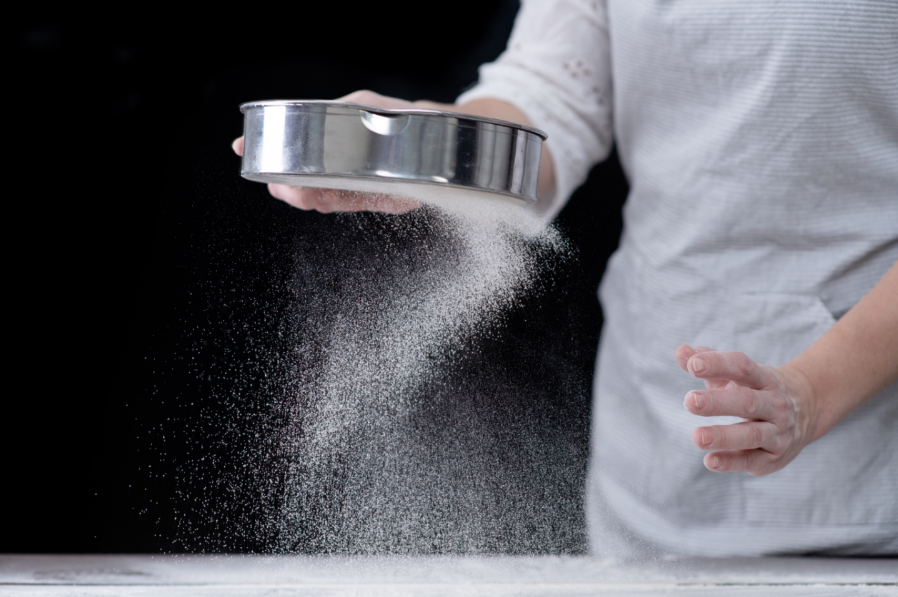
Firstly let us consider sieves in the culinary sphere, because in looking at sieves this is what most people think of.
Many cooks have many sieves : sifters, colanders and strainers for different tasks. The salient differentiating feature is the size of holes.
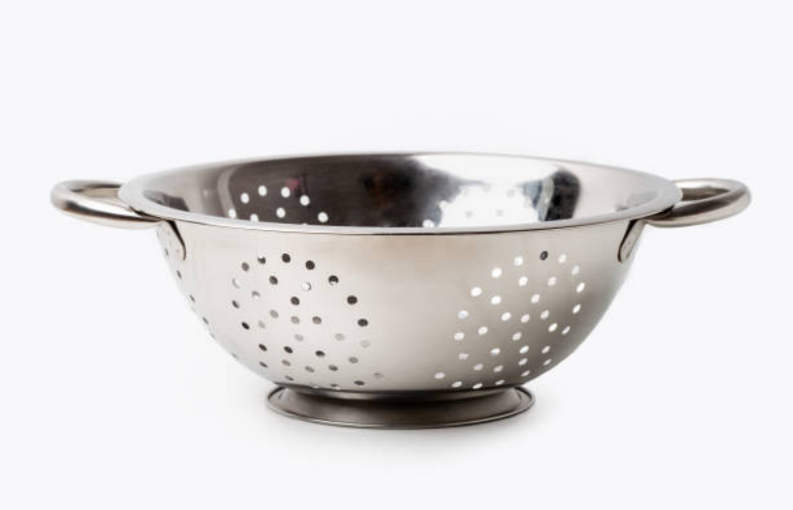
Colanders have the larger holes for draining liquid, as from pasta, or rinsing produce such as lettuce, fruits and vegetables or draining canned foods. (If you want to save the liquid from canned beans (aquafaba) to be used for other recipes, place colander over a bowl to collect the liquid.)
 |
 |
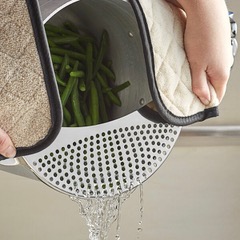 |
Strainers have smaller holes for greater filtration (sometimes just called a sieve.) Used for for removing seeds and pulp, tea leaves, rinsing rice, skimming solids from hot oil, separating curds from whey, or straining yogurt to make labne: a sort of cheese. Strainer baskets can be dipped into boiling water to blanch vegetables.
 |
 |
Some may use a China cap strainer : perfect for removing seeds from soft foods. A cone shaped pestle can be pushed onto the sieve to move the food. (not to be confused with the Chinois Strainer– described next)
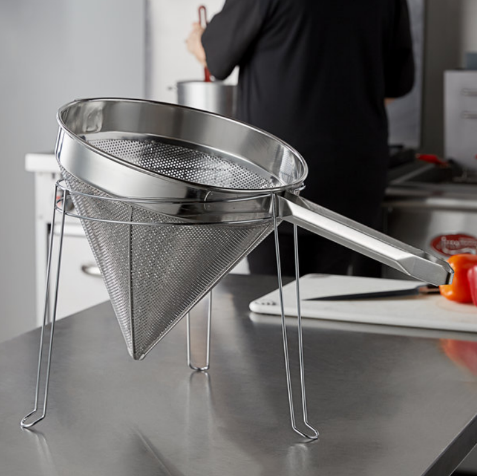
The China cap strainer
The Chinois strainer has a finer mesh to get a very smooth texture with purees and sauces.
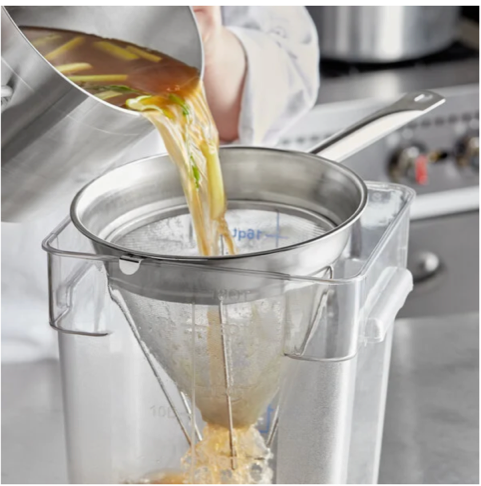
The Chinois strainer
Perhaps you need an even finer cloth mesh strainer for baby food or nut milks.

The cocktail strainer has small mesh and fits over a glass or cocktail shaker to strain ice and muddled herbs.

The cocktail strainer
The tea strainer is in this category of fine meshed items, whether a tea cup strainer or a tea-ball strainer.
 |
 |
Now we come to sifters. Again there is a variety of modes of operation and in size of holes.
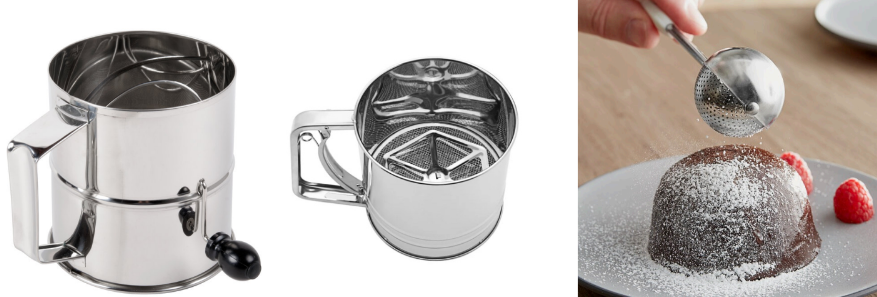
These sifters are used for sifting dry ingredients or dusting desserts
Industrial Sieves
Not surprisingly industries use sieves with specifications as to sieve size. The sieve size measures the number of openings in the mesh that make up one inch.
Determining what size mesh is needed is crucial for uses in concrete, cement and the pharmaceutical industry. It of course must be exact. Charts are available to determine the exact size mesh required in a particular sieve and are numbered accordingly and understood in the
different industries.
Particle size analysis (using a series of stacked sieves) can determine particle size distribution necessary for the correct formulas.
Today laser diffraction is becoming the standard particle sizing technique across many industry sectors, including optical instruments.

Sieving is crucial to get the correct formula for concrete

Different size mesh openings are needed for sorting those larger diamonds than needed in prospecting for gold.
 |
 |
Molecular Sieves
Molecular sieves are synthetic zeolite materials engineered with pores of precise and uniform structure and size.
Many people do not realize all of the applications of molecular sieves that help to improve our everyday lives. Almost every imaginable product has been touched by molecular sieves in some way. From steel production, insulated glass windows, fuel ethanol, and oxygen for breathing apparatuses, to the air conditioning filter cores in our cars, molecular sieves are a part of our lives every day.
The most important substitutes for phosphates in laundry detergents are zeolites and polycarboxylates. Phosphates are now largely banned from dish detergents and washing detergents, and there are less phosphorous-fed algae in rivers and lakes.
For this we can thank Edith Flanagan b.1929 who while working in her 50 year career at Union Carbide began working on molecular sieves in 1956. She is known as the inventor of zeolite Y – a specific sieve, now used in detergents instead of phosphates.
Among her awards, she was inducted into the National Inventors Hall of Fame in 2004. In 2014 President Obama presented Flanagan with the National Medal of Technology and Innovation for her contributions to science.


Edith Marie Flanagan noted American chemist known for her work on molecular sieves receives award from President Barrack Obama in 2014.
The Mathematical Sieve
The Sieve of Eratosthenes is an ancient algorithm for finding all prime numbers up to any given limit. Again all a matter of sorting and filtering.
The earliest reference to this sieve is in early 2nd century BCE and is a popular way to benchmark computer performance today.

The sieve of Eratosthenes to find all prime numbers

Eratosthenes born 276 BCE in Greek colony of Cyrene. An “all rounder” calculated the Earth circumference, a system of longitude and latitude as well as the sieve which is still in use today
The Sieve as a derogatory term
Sports Without using profanity the most derogatory thing you can call a goaltender is a sieve: a bad “leaky” goaltender what lets too many goals into his net.
“Sieve! Sieve! Sieve!” Sound familiar? If you’re an ice hockey fan, you know this chant. In fact, you may have participated in attempts to rattle the opposing teams goalie. A goalie says “What a rush! Stop the puck, and you’re the hero! But miss it, and……”
The term is particular to hockey but also used in other sports if goalies let in goals.


Some more perspective and quotes concerning the sieve.
Someone who cannot keep a secret is often called a sieve.
E-mail filtering systems are based on the sieve concept of applying rules so as to block certain emails and allow others to flow through.
Triage sieving refers to grouping people according to their severity of injury.
“If you read fast and read all, maybe some of the sand will stay in the sieve.”
― Ray Bradbury, Fahrenheit 451
If you keep forgetting things, you can describe your “mind like a sieve,” since it doesn’t seem to hold much.
But on the other hand if one retains the important parts perhaps having a “mind like a sieve” is an attribute!
“The wise ones fashioned speech with their thought, sifting it as grain is sifted through a sieve.”
— Buddha
“Two things are easiest to do.
One, to carry water in a sieve.
Two, to still the mind.
Freeze water. Breathe calm. Only two secrets to learn.”
— Swami Veda Bharati
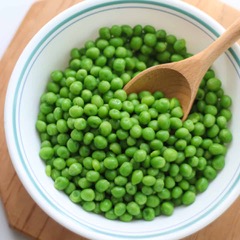
We may now have newfound respect for dinner as we realize that it is the
sieve is simply filtering fresh peas so we may have uniform size frozen peas!
Notes and Links.
Photo of Jill : Joe Mazza Bravelux inc.
Photos copyright © 2023 Jill Lowe. All rights reserved
Images with Shutterstock license
Ann Lewis: Retired history teacher Canberra, ACT Australia






